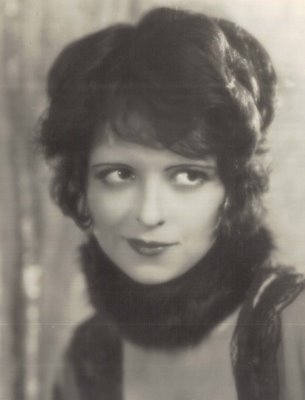

Monday Glamour Starter --- Clara Bow --- Part One
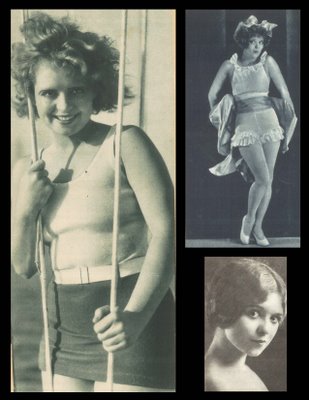
The more I watch and read about Clara Bow, the more convinced I am that this woman was a genius performer, not, mind you, a mere "instinctive" one. That implies an actor too dim to realize their effect on an audience. Clara Bow understood exactly what she was doing. Her grasp --- her technique --- was never any accident. She was not taught by force of repetition to run and fetch her stick, even as there were plenty who treated her as though she were that sort of trained pet. If Bow had known and been able to protect her talent, had she but come of a marginally functional background, then here would have been recognized a most accomplished actress of her generation. In that event, however, she would not have been Clara Bow anymore. She might instead have been Colleen Moore, or Sue Carol, or any one of runner-ups so much better equipped to protect themselves against studio threshing machines that finished Clara off. To hear observers tell it, and these were top people in the business, Clara Bow was a most capable artist they had ever worked with. Victor Fleming still said it twenty years after the fact, and he had directed all of biggest names through the interim. We could appreciate Bow more if Paramount hadn’t allowed most of her pictures to rot. Beginner work in circulation is less polished, and survives if at all on 16mm. The Plastic Age, Dancing Mothers, Parisian Love --- each anticipate the magic, but none show Clara to a best advantage. Of vehicles available, It alone gives us a shimmering Bow, the DVD affording a Clara Bow audiences routinely enjoyed during her prime. My mother was ten-years old the year Bow made It, and Clara was her favorite actress. That generation was sole repository for first-hand memories of these --- Red Hair, Three Weekends, The Fleet’s In, Get Your Man, Rough House Rosie, Ladies Of The Mob --- the list of the lost goes on, and it would take an archiving miracle to turn any of them up now.


Part of the reason they loved Clara was that so many could identify with her, women especially. She was the original shop girl heroine. Who was early Joan Crawford but carbon facsimile of Clara? The depression was better suited to cheerless ribbon clerks Crawford would play, always knowing the score, but not getting much fun from it. Clara Bow wasn’t the only personality hobbled by talkies. Microphones drained vitality out of all the Dancing Daughters, leaving us with dour substitutes, or like Crawford, beaten-down worker girls struggling to protect virtue from predatory playboys and lecherous landlords. Clara’s day had come and gone by this time, her can-do flapper spirit a weak opponent to joblessness and starvation. Just being Clara Bow would no longer be enough. Irony was off-screen Clara understanding better than any what it was to be without and deal with predators (her family a worst of those). Beaten-down was a literal term as it applied to her. That Clara Bow even lived through her childhood is some kind of remarkable (for account of that, see David Stenn’s definitive biography). Clara’s horrific ordeal of privation and abuse is not for recount here. Read the book so I may skip whole of the ugly saga and go instead to her movie star pinnacle, but wait, it gets ugly there too ...


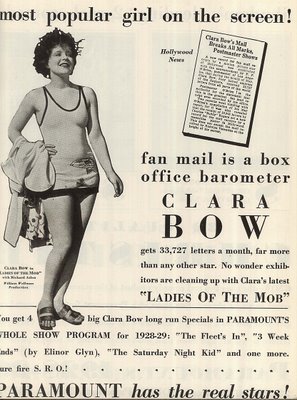
Should you want to see mere actors exposed as such, look at Clara Bow’s support cast in 1927's It. They function well enough, adequate a fitting word, but it is Clara lighting up the place, and not mere because the movie is thrown to her. Every move and gesture is spontaneity itself, a primer on how to transcend limitations of a projected image in order to reach out and become one with your audience. She soon enough became the pivot around which Paramount’s release season revolved. Exhibitors accepted any number of clucks from studio block booking to get four per year serve of Bow. Working a hopeless insomniac for eighteen hours a day was insidious means by which those contracts got fulfilled. Quality was incidental since the public was buying Bow any way they could have her. She was Paramount's sow ear to silk purse girl, and formula though they were, her silents kept right on selling, almost despite themselves. Her jazz baby thumb-nosing at convention was endearing for a while, but Clara flew in the face of too many Hollywood sacred cows, and she was made to suffer for it by way of outcast status unheard of among stars of her stature. How could you be Number One at nationwide boxoffice and not be invited to parties or dinners? Men paid court in droves --- she was known well for putting out --- this another reason for much of the town shunning her. Conquests (hers, not theirs) included aforementioned Victor Fleming, Gilbert Roland, a starting-out Gary Cooper --- she liked Cooper because, as she put it, he let her dog share the tub when he gave Clara morning baths. Scandal rags got in their licks, tall tales thrived right into the seventies with the publication of Hollywood Babylon, a tickle-me wool gathering of filthy anecdotes, one of them alleging Clara had serviced the entire USC football squad during nighttime orgies in her home. Author Stenn put that story to rout by tracking down surviving team members. Based on chaste, and believable, accounts of their association with Clara, these boys sound more like college students from The Plastic Age (another of Bow's early starring parts) than any product of Kenneth Anger’s fevered imagination.

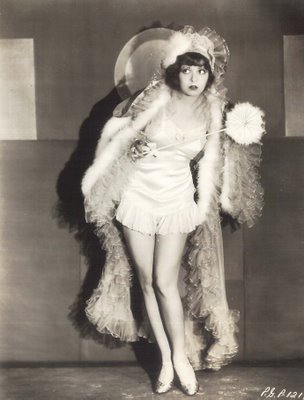
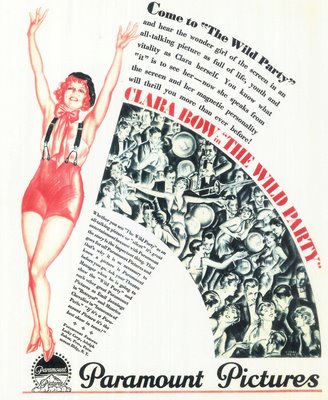
This is how nice Clara could be to her fans. There was a kid who sent a letter to Paramount, lamenting the fact that his parent’s candied popcorn concession at Long Beach would soon go under owing to family illness and rising medical expense. Could Clara come down and help out? To the boy’s no doubt total shock, she did just that, showing up unannounced one Saturday morning to peddle the corn. All her idea too, not the publicity department’s. The 33,727 letters she received in May 1928 were no doubt sincerely felt. Nobody in the industry got more mail. By this time, Clara was frankly sick of "actin’ with my clothes off," but to eternal gratitude of all and sundry, she kept doing just that. The curtain began lowering with the arrival of sound, about a worst calamity that could befall a star of Bow’s temperament and limitations. That story’s for Part Two, but for now, here’s an ad heralding The Wild Party, wherein Clara’s voice would herald the beginning of the end for her screen career.
6 Comments:
I have only seen It, but the thing that impressed me the most about Bow was the expressiveness of her face and how quickly and clearly she could communicate with it. That ability had to be handicapped by dialogue, as words are just too slow. I've seen clips of Bow from talkies, and it's like she's acting underwater, forced to wade through the dialogue instead of being able to let her eyes do the work.
There was a 35mm print screening of WINGS at the Sunrise Theater in Southern Pines, NC last March. However what I believe made this screening special was the guest we had was Diana Cera Carey (Baby Peggy) who had known Clara Bow personally. Earlier that same day they showed a digital copy projected onto the big screen of Mrs. Carey's feature CAPTAIN JANUARY and let me tell you, there was not a dry eye in the house after this 1923 movie. It was a fun-filled day for silents with live piano music provided by David Drazin from Chicago.
Only two comments for Clara Bow? For shame - she was a stunner!
I can't agree with Mr Mayerson though - she's great in the insane Call Her Savage...
Everyone really interested in Clara Bow should read David Stenn’s biography of her: Runnin' Wild
Old post, I know, but I had to check out my Clara first after "following" your blog! It's terrific!
Thanks for the kind words, Avalon, and very glad you liked the Clara post!
Post a Comment
<< Home